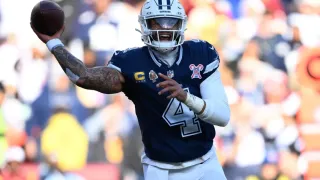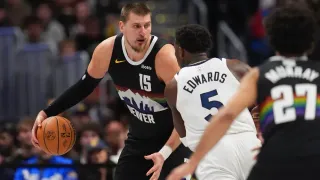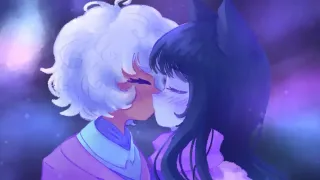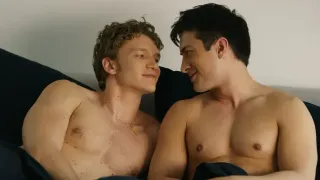May 7, 2017
Queer Comics Leave the Closet Behind
Matthew S. Bajko READ TIME: 5 MIN.
In the "Lumberjanes" comic books the action has literally moved beyond the proverbial gay closet and into the woods. The acclaimed series centers around a group of girls of various sexual orientations and gender identities at a Girl Scout-like camp who battle supernatural spirits.
Launched in 2014 by Boom! Box, an imprint of Boom! Studios, the ongoing series has drawn high praise from critics and earned several awards. It has also been a platform for its creators to introduce young readers to different queer topics, from using the proper pronouns for someone who is genderqueer to portraying a family headed by a same-sex couple.
"We wanted it to be something casual and easy for kids to understand and not make it a big to-do," said Kat Leyh, a Chicago-based comics writer and artist who is a co-writer and cover artist for the "Lumberjanes" series. "It normalizes their pronouns and is good for kids to see."
"We really wanted queerness to be normal, that was nonnegotiable," added "Lumberjanes" writer and co-creator Shannon Watters, who lives in Los Angeles and is an editor at Boom! Studios. "At camp among this group of friends, queerness is normalized. For kids that read that, it can be normalized for them too."
Just as LGBT movies and literature have largely left behind the trope of a main character struggling to accept being homosexual, so too have today's queer comics creators moved beyond coming out storylines to tackle a far wider array of subject matter.
That development was on full display at the recent Queers and Comics Conference held in San Francisco, where the "Lumberjanes" co-authors took part in a panel highlighting titles aimed at young adult readers. As the award-winning queer Canadian born artist and writer Mariko Tamaki pointed out during the panel discussion, there is no longer a need for a comic book to include a panel depicting a character crying as they come out.
In some titles, there is only the briefest of mentions of a character's sexual orientation or gender identity, noted Tamaki, as it is taken for granted that readers will be able to figure that out on their own.
"I think it is the real revolution. We of queer comics we don't have to address this character's gayness. There are gay kids at camp and you will just know it," said Tamaki, who now lives in the Bay Area and is writing a new "Hulk" series for Marvel Comics and the mini-series "Supergirl: Being Super" for DC Comics.
While she has no leeway when it comes to the sexual orientation of the main characters in those titles, Tamaki said she is able to pepper the stories with LGBT characters and purposefully makes them "the smartest ones" in the cast.
"I always put a gay in there," said Tamaki. "I am obsessed with the gay best friend."
And she also uses words in her comics that are often censored in mainstream publications, a practice gay fellow cartoonist Brian Andersen noted during their panel presentation about queer comics for children, as well as adult readers.
"I like you saying 'dyke' in 'Supergirl.' It is so powerful," said Andersen, who grew up in northern California and is the creator of the Mormon superheroes comic series "Stripling Warrior."
Stories and Readership Diversify
Today's queer comic titles are also drawing a more mainstream audience, said Justin Hall, 46, a gay San Francisco resident and cartoonist who edited the 2012 book "No Straight Lines: Four Decades of Queer Comics."
"For their first couple of decades queer comics existed in their own solo universe from the rest of the comics world. They materialized in queer newspapers and were sold by queer publishers and sold by queer bookstores," said Hall, an assistant professor of comics at the California College of the Arts, which hosted the queer comics conference last month. "They didn't overlap with mainstream comics and were not published in non-queer newspapers. My generation was responsible for bringing the queer comics into the rest of the comics industry."
As an example, he pointed to how Alison Bechdel, the creator of the "Dykes to Watch Out For" comic strip, for decades was overlooked outside queer comics circles until the release in 2006 of her autobiographical graphic novel "Fun Home." It went on to be turned into an award-winning Broadway musical.
"Queer comics existed in this queer media ghetto. Now it has changed," said Hall. "More and more comic book stores are selling queer material. Also, we have had queer characters and themes really making a mark in mainstream comics."
The internet and growth in social media platforms have also had a hand in bringing the work of queer comics authors to a larger audience.
"There has been a massive, massive broadening out of queer comics on the web and with independent publishing," noted Hall.
San Francisco resident Tyler Cohen has been drawing comics "on and off" since the late 1990s. Her latest work, "Primahood: Magenta," is based on her experiences raising her daughter, who is now 11 and goes by the pseudonym Nene in the book, with her partner of 19 years, Raleigh Freeman. Cohen, who identifies as queer and bisexual, based the Mamapants character in her work on herself.
"Having a kid was not a planned situation but embraced," Cohen said. "It threw me into a much more heterosexual environment than I am used to being in. It was a very isolating experience, I have to say."
She turned to cartooning to work through the issues she was facing as a parent, as well as the experiences her daughter was encountering because she is of mixed race and Jewish. It is one example of how the topics queer cartoonists are tackling have advanced beyond coming out narratives.
"There is an incredible breadth of voices and language in cartoons. There are as many styles and languages as there are personalities and queernesses," said Cohen. "I think that is really beautiful and powerful. The work has moved beyond the coming out story."
For Jennifer Camper, the creator of the biennial queer comics conference, what has been most satisfying is seeing the breadth of topics and genres queer cartoonists are tackling in their work.
"What I am loving is that it is incredibly diverse. We find queer cartoonists working in every genre, from science fiction and fantasy to memoir to historical comics to political comics, humor, erotica, comics about health, and young adult works as well," said Camper, a dyke and freelance cartoonist who lives in Brooklyn, New York.
While having queer cartoonists working on mainstream titles is a significant achievement, Camper said it is just as vital that queer comic books are embraced by all readers and find commercial success.
"It is all important. That we have representation in mainstream comics, and it is also important to have queer cartoonists who push the boundaries in what can be done in comics," said Camper. "There is really exciting new ways to create art with words and pictures in the independent world of comics."






